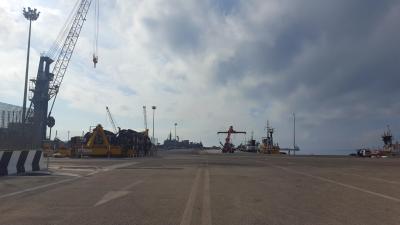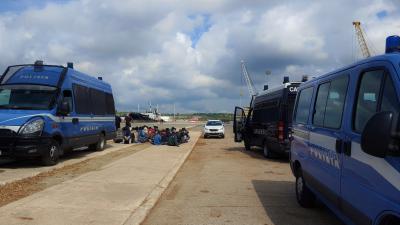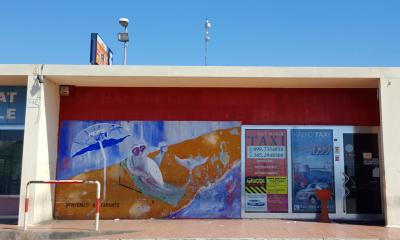Guest post by Simon McMahon, Research Fellow at the Centre for Trust, Peace and Social Relations at Coventry University. He is the author of Immigration and Citizenship in an Enlarged European Union (Palgrave, 2015), editor of The Handbook of International Political Economy of Migration (co-edited with Leila Talani, Edward Elgar, 2015) and researcher on the MEDMIG project on Europe’s recent migration ‘crisis’. Simon is on Twitter at @si_mcmahon.

Some would be relieved, others concerned about what might lie ahead. Many would find that the system designed to process their arrival and protect them would result in a precarious life. Efforts at increasing control over migration are producing uncertain futures for many of those crossing the Mediterranean to Europe.
Since 2014, nearly half a million people have crossed the sea from North Africa and landed in Italy. Many have also left Italy, continuing their journey northwards to other countries. In response, throughout 2015 European leaders sought stricter identification of new arrivals at ports to distinguish between refugees and so-called economic migrants. Four closed centres were also established at ports in Italy, known as ‘hotspots’, where new arrivals could be contained and identified. Following this, they could either be relocated elsewhere in Europe, transferred to refugee reception facilities while their asylum claims were processed, or returned to their country of origin. As Jean-Claude Juncker, President of the European Commission, put it: ‘people must be registered. No registration, no rights’.
Over the past year, I have been visiting ports, hotspots and reception facilities in the south of Italy as part of my research into Europe’s so-called migration crisis. The Interior Ministry claimed their approach would ‘improve the capacity, quality and efficiency of systems of asylum, reception and deportation’. But I have seen that while many more new arrivals are now fingerprinted and identified, implementing stricter identification and hotspots has been riddled with contradictions.
Everyone who passes through Italy’s hotspots is required to give their name, age, nationality and fingerprints. If they then leave without documents or apply for asylum in another EU country, the record of their fingerprints on a centralised EU database ensures that they can be sent back to Italy. But a recent report by Amnesty International found cases where physical and psychological abuse were used to record fingerprints. It is no surprise if people who suffer violence on their arrival then seek a way out.
However, the failings of Europe’s border regime go beyond implementing identity checks. What we see today is the containment of migrants in Italy and new forms of precarious lives provoked by the intensified efforts to control the border.

Italy’s reception centres and asylum system lack the capacity to deal with the situation. Processing times are long and unpredictable, leaving people in limbo. To free up space, the Italian authorities have adopted a stricter approach to asylum applications from countries that are not at war, increasing the number of rejections considerably. Since late 2015, ‘deferred expulsion orders’ have become more common, given mainly to people from West African countries and demanding that they leave Italy within seven days.
The system is creating anxiety among those entangled in it. As M., a Ghanaian man I met almost a year ago said to me, ‘I pray to God and to the asylum commission … I have no date but did my fingerprints already … There have been deportations to Ghana, I am scared. I am not sleeping well because of the fear. If they send me back now, why do they want me to go to Ghana, to do what? To rob? To beg?’.
For those trying to reach family elsewhere in Europe, or not wishing to stay in Italy and wait in uncertain asylum or relocation systems, there are few options. Countries to the north have introduced tighter border checks on undocumented migrants in an effort to stop them crossing. Hundreds set up a camp in Como, after being pushed back from the Swiss border. The same could be seen in Ventimiglia, on the French border, as well as the increased checks that were placed between Italy and Austria.

Sending these people back to a hotspot is unnecessary and expensive, with each bus taking them from Como to Taranto costing 5,000 Euros. But above all, it is alienating for the individuals involved. When their details are found on the system, the security gates open and they are simply deposited outside, left to find their own way home somehow.
The limitations of the hotspot approach and other responses which the EU has so far put in place are driven by a demand for control of migration at all costs and a lack of solidarity to share the burden. But they are at the same time producing new forms of precarious lives for the people arriving at Europe’s southern borders. The current system ensures that the people arriving in Italy’s ports and reception facilities frequently come face to face with what Nick de Genova has called their ‘deportability’: even if the Italian government does not physically expel them from its territory, the possibility that they will be removed from reception centres or picked up and deposited far away at short notice means that their futures remain uncertain. The true extent of this might not be seen for years to come, but for now it is clear that a deep contradiction lies at the heart of the European border regime: although there is consensus on the value of saving lives at sea, there is less agreement about what should happen beyond that.
Any comments about this post? Get in touch with us! Send us an email, or post a comment here or on Facebook. You can also tweet us.
Share:








